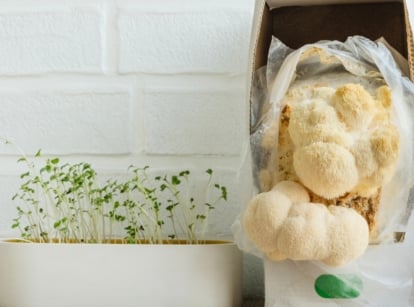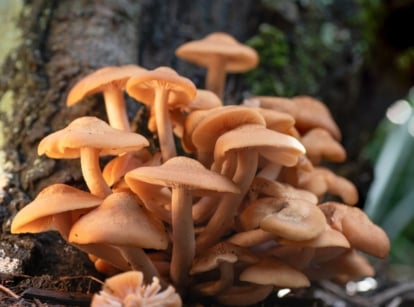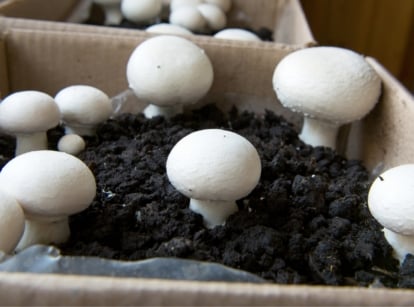11 Best Mushroom Growing Supplies for Home Growers
Mushroom lovers should try growing at home! It’s rewarding to see your hard work and cultivation result in dozens of delicious mushrooms. Join naturalist Jerad Bryant in discovering these eleven indispensable tools for cultivating fungi at home.

Contents
Whether growing mushrooms indoors or outdoors, there are simple tools that make it an easy process. Unlike plants, fungi need sterile conditions to grow indoors. They compete with molds and mildews that have abundant spores. We’ll use a few tricks to sterilize these unwanted pathogens to encourage ample fungal growth.
In the outdoors, fungi have more natural defenses that help them resist environmental pressures. If you live in a region where lots of mushrooms grow in late summer and fall, spawning mushrooms outdoors may be a better option for you than indoors. It requires less maintenance and has higher yields with fewer inputs.
No growing situation is wrong! You want to create a setup that works best for you, your home, and your fungi. Gather these supplies, and you’ll have everything you need to start growing mushrooms at home.
Indoor Grow Setup

Indoor grows typically use spawn bags or plastic tubs for controllable harvests. Tubs are great for large harvests, and they require some care to set up. Bags work better for beginner growers, as they’re easy to manage and small enough to fit anywhere in your home.
90% Isopropyl Alcohol

Because mold and mildew spores are abundant inside homes, some sterilization is necessary to ensure they don’t compete with your sensitive fungal spores. 90% isopropyl alcohol is ideal; it evaporates quickly and kills most pathogens.
You’ll use alcohol to sterilize your buckets, bins, tools, and other growing media. You’ll also turn off fans while you cultivate fungi to ensure disease spores don’t waft about in the air. Successful indoor growing relies on a clean, sterile environment for sensitive fungal bodies to sprout and fruit successfully.
Mushroom Spawn Bags

Spawn bags, or fruiting blocks, are containers full of inoculants with mushroom spawn inside of them. The inoculant is typically a grain like cork kernels, rye, or wheat. These grains are optimal for fungal growth, and they house the mycelia that act like plant roots for the mushrooms.
These bags grow mushrooms on their own, or you can distribute the inoculant in plastic bins with the substrate to make a larger harvest. “Substrate” is another term for growing media, like potting soil for plants.
You have two options for spawn bags: make them yourself, or find them pre-inoculated online. Making them requires low airflow, a clean workspace, and sterilized growing media. They often come premade in small kits that you can use on the countertop or spawn kits for spreading directly into the substrate.
Plastic Bin

Plastic bins are only necessary if you’re growing a large tub of mushrooms. Most beginning home growers should start with grow bags and move to bins after learning a bit about the process. Clear storage containers work well, although you can also find special pre-cut bins for mushrooms. You’ll take the inoculated spawn bag, break up the inoculant, and mix it with the substrate in the bins.
For proper airflow, you’ll need to cut six air holes in each container. Make two round holes one inch in diameter on opposite sides of the bin. Cut them three inches above the bottom. Then, cut two additional holes, one on each side. Make these additional holes three inches below the top of the bin.
Tape

Tape blocks the round holes you cut in the plastic bins. Two different types of tape work well. Painter’s tape, or a similar type, lets some airflow through during the colonization step, where the mycelia spread throughout the substrate. Paper tape is better for the fruiting step, where mycelia sprout mushrooms out of the substrate.
Start the process with painter’s tape, then switch to paper tape for the fruiting phase. The fruiting phase begins two to three weeks after the spawn colonizes the substrate in your bin or bucket.
Substrate

The substrate is what your mushrooms grow in! It’s a bit different than potting soil for plants, as fungi prefer different growing mediums to thrive. They colonize dead organic material and turn it into rich humus for shrubs and trees to access.
The best substrates for mushrooms are coco coir, straw, wood pellets, pasteurized manure, and sawdust. Some fungi prefer growing on certain mediums, so research the variety you’re growing to ensure you use its preferred substrate.
If you’re using beginner grow bags or fruiting blocks, you won’t need substrate. These kits come ready to sprout from their container, requiring little care or maintenance outside of daily misting.
Bucket

Buckets are optional supplies for growing mushrooms indoors. You can use them instead of plastic bins for larger grow setups, or you can use them to sterilize substrate and inoculant. A five-gallon bucket is an indispensable tool for us gardeners; it has many uses outside growing mushrooms.
Sterilize grains or substrates by boiling water and pouring it over your chosen medium in the bucket. Let it soak overnight, then use the material for spawn bags or growing bins.
Outdoor Grow Setup

Outdoor grows require some setup, although they’re relatively easy to care for after you start them. You’ll let Mother Nature take care of the fruiting fungal bodies for maximum harvests. This method is best for gardeners who live in zones conducive to mushroom growth. Choose tropical varieties in warm climates and temperate ones in cool regions.
Logs or Garden Beds

Wood logs are the ideal spawning grounds for outdoor fungi. Mushrooms naturally grow out of them, so why not let them do the same in your backyard? Log sprouting is best for species that live on wood, like shiitake and blue oyster. They need specific trees to grow well; consult guides for each species to determine which wood to use.
Other species, like wine caps and pink oysters, prefer growing in substrate outdoors. Use a suitable material like straw, wood chips, or sawdust. These species need garden beds under deep shade rather than wood logs.
Plug Spawn

Plug spawn are pieces of wood with fungi growing in them; you push them into logs. The fungi spread their tendrils from the wood pieces into the logs and colonize the site. Plug spawns are easy ways to start growing mushrooms outdoors. Buy them once, and you’ll have fungal fruiting bodies in your yard for years.
Some kits have most of the materials you need to start growing mushrooms with plug spawn. They contain drill bits, wax for sealing, and instruction guides so you have everything you need in one place. Without plug spawn, try sawdust spawn or inoculated substrate for spreading fungi outdoors.
Drill with Drill Bit

You’ll need a drill with a drill bit if you’re cultivating mushrooms on logs. Whether using plug spawn or sawdust spawn, holes in the wood allow you to push the inoculant deep into the log so it can colonize the wood.
Sawdust spawns require large, round holes. Use a drill bit like the one in this trio to ensure you make holes of the proper size. Plug spawn kits require different holes that most traditional drill bits work well for.
Sawdust Spawn Tool

Plug spawns are easy to push into holes in wood logs, but how do you inject sawdust spawn? Instead of pushing it in with makeshift objects, try using a sawdust spawn injector tool that pushes it for you. Simply fill the injector with sawdust, place the tip at the hole’s entrance in the log, then push the sawdust in.
After many injections, this tool may face a buildup of sticky sawdust. Soak it in hot, soapy water for thirty minutes, then push the injector to dispense any debris.
Wax Daubers

Wax is an indispensable tool for outdoor grow setups involving logs or wood stumps. After drilling holes and injecting spawn into them, you’ll need something to seal the holes. Sealing ensures the fungi stay moist and protected inside the wood so they can colonize the rest of the logs.
Use food-grade paraffin wax to seal the holes, as it’s an organic substance that’ll decay in nature. Some growing kits have daubers for easy application, although you can use cotton balls or Q-tips instead. The wax must be hot and runny so you can apply it; use a crock pot outdoors to keep it warm if you’re applying spawn in the fall or winter.












